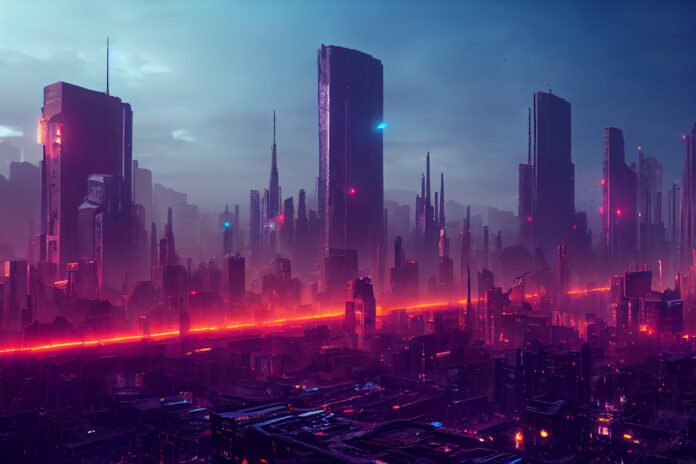The cyberpunk genre has captivated audiences for decades with its gritty portrayal of a dystopian future. Where advanced technology intersects with a dark and chaotic society. Originating in the 1980s, cyberpunk art, literature, films, and video games have left an indelible mark on popular culture. Since then it has been inspiring artists and creatives across various mediums. In this article, we delve into the captivating art of cyberpunk, exploring its visual aesthetics, literary themes, and influence on real-world technology and culture.
Visual Aesthetics of Cyberpunk
Cyberpunk’s visual appeal lies in its ability to create vivid and immersive dystopian urban landscapes. Neon-lit streets adorned with towering skyscrapers, bustling marketplaces, and decaying infrastructure characterize these environments. The juxtaposition of high-tech gadgets, futuristic fashion, and gritty settings creates a unique atmosphere. An atmosphere that transports viewers to a world on the edge of collapse. The vivid color palette, with vibrant neon hues contrasting against dark shadows, further enhances the sense of unease and dislocation.
Literary Themes in Cyberpunk
Beyond its visual allure, cyberpunk delves into thought-provoking literary themes. At its core, it explores the human condition in a technologically advanced society. Cyberpunk narratives often center around individuals who navigate a world ruled by powerful corporations, challenging their influence and control. These stories also delve into questions of identity and existence, as characters grapple with the blurring boundaries between physical and digital realms, and the impact of technology on personal agency and freedom.
Film and Television Representations
Cyberpunk’s influence extends to the realm of film and television, where iconic works have shaped the genre’s imagery and narrative tropes. Films like “Blade Runner,” “The Matrix,” and “Ghost in the Shell” have become touchstones of cyberpunk. Each showcases distinctive visual styles, complex storytelling, and profound societal critiques. These cinematic masterpieces have not only entertained audiences but have also had a lasting impact on popular culture. And are still inspiring countless creators in their artistic endeavors.
Cyberpunk Art and Illustration
Artists have embraced cyberpunk as a rich source of inspiration. They are producing breathtaking artwork and illustrations that capture the essence of the genre. From visionary concept art to stunning digital paintings, cyberpunk art often showcases dynamic cityscapes, augmented humans, and futuristic technology. Pioneering artists like Syd Mead, H.R. Giger, and Masamune Shirow have contributed immensely to the genre’s visual lexicon. By pushing the boundaries of imagination and challenging conventional artistic norms.
Cyberpunk in Video Games
The interactive medium of video games has embraced cyberpunk, allowing players to immerse themselves in the genre’s worlds like never before. Games like “Deus Ex,” “Cyberpunk 2077,” and “System Shock” offer players the opportunity to explore sprawling metropolises, make impactful choices, and experience the consequences of a technology-driven society. The interactivity of video games enables players to engage with cyberpunk themes on a personal level. Allowing them to shape their own narratives within these complex and immersive worlds.
Music and Sound in Cyberpunk
Soundscapes and music play a pivotal role in creating the atmospheric backdrop of cyberpunk. Synthwave, a genre characterized by nostalgic synthesizer sounds, echoes the futuristic feel of these worlds, while industrial music evokes the genre’s gritty and dystopian aspects. These genres, along with haunting sound design, immerse audiences further into the cyberpunk experience, heightening the emotional impact of the visuals and narratives.
Influence of Cyberpunk on Real-World Technology and Culture
Cyberpunk’s influence extends beyond the realm of fiction, with its concepts and aesthetics permeating real-world technology and culture. The genre has inspired and influenced technological developments, from the advent of virtual reality and augmented reality to the rise of artificial intelligence and surveillance systems. Cyberpunk’s cautionary tales and societal critiques have resonated in contemporary culture. And have been sparking conversations about the ethical implications of emerging technologies. And also the balance between individual privacy and corporate power.
Conclusion
The art of cyberpunk captivates and provokes, showcasing a captivating blend of visual aesthetics, thought-provoking themes, and a glimpse into a dystopian future. From its origins in literature to its influence across film, art, video games, and music. Cyberpunk continues to captivate audiences and shape the creative landscape. Its enduring appeal lies in its ability to mirror our hopes and fears about the convergence of technology and society, urging us to question the potential consequences of our own digital frontier.
And as always folks be sure to check the latest article The Art of Steampunk: Creating Retro-futuristic Designs with Victorian-inspired Aesthetics. Also, if you would like to read some of the latest articles in Hindi be sure to check out the Mojo Patrakar.









